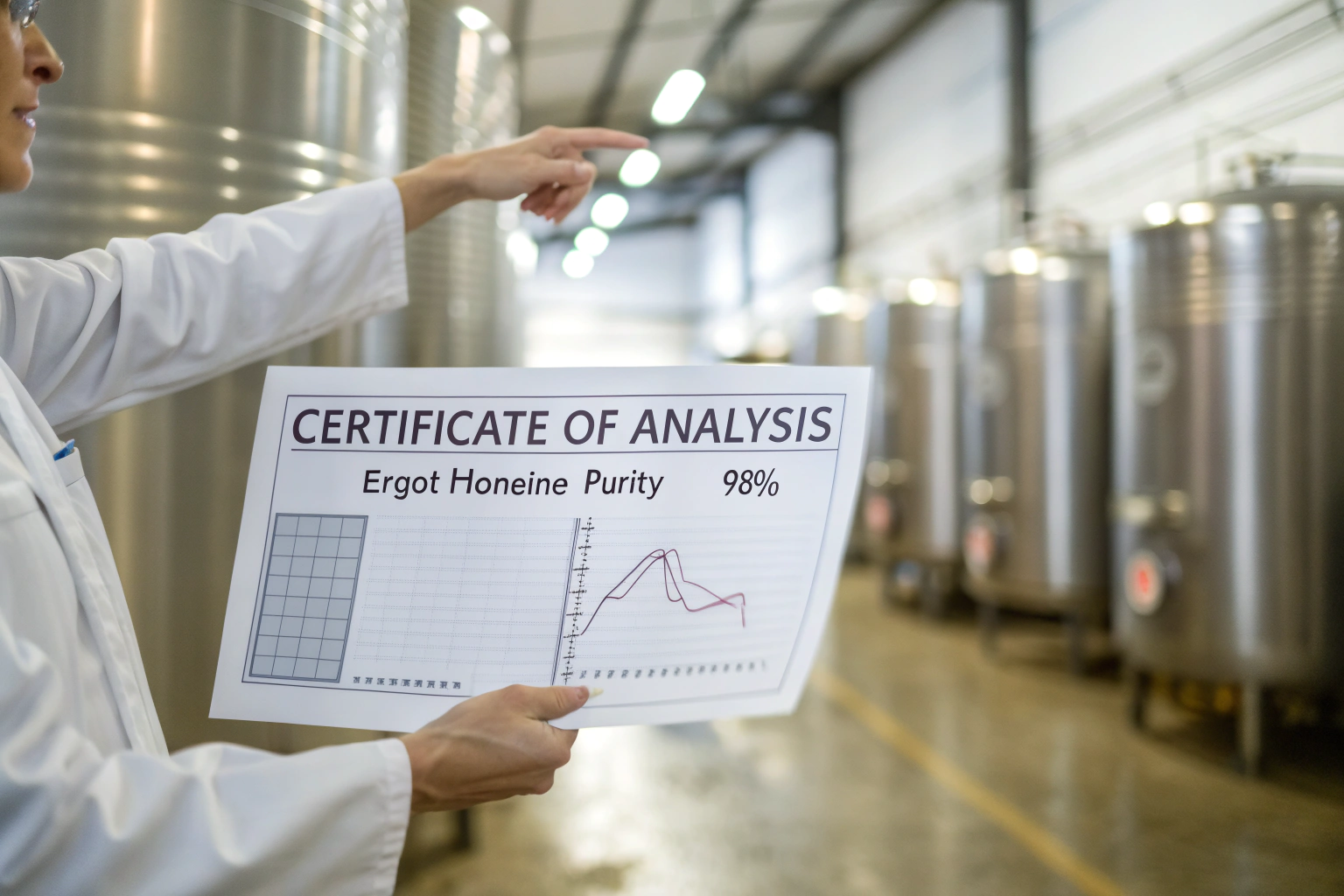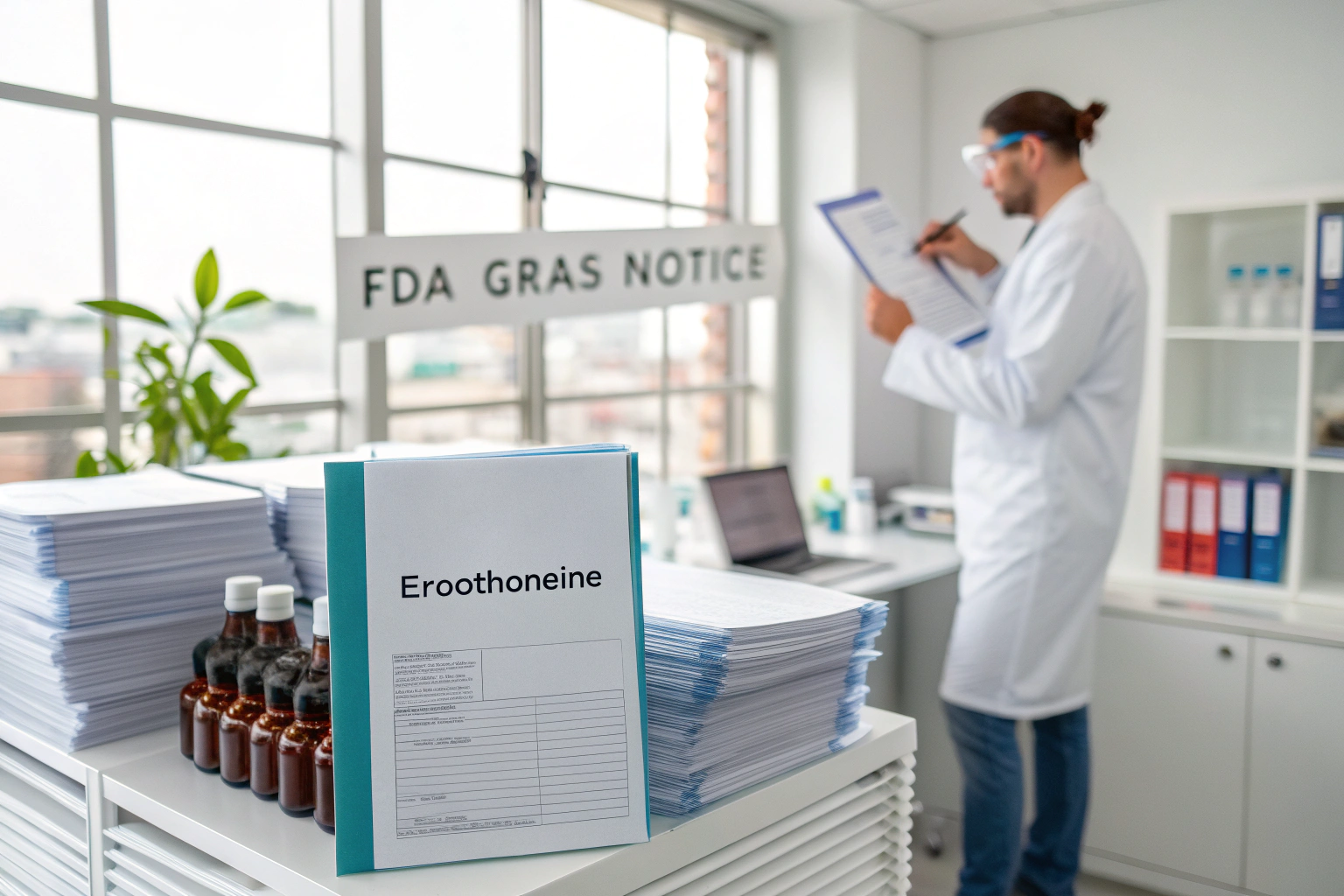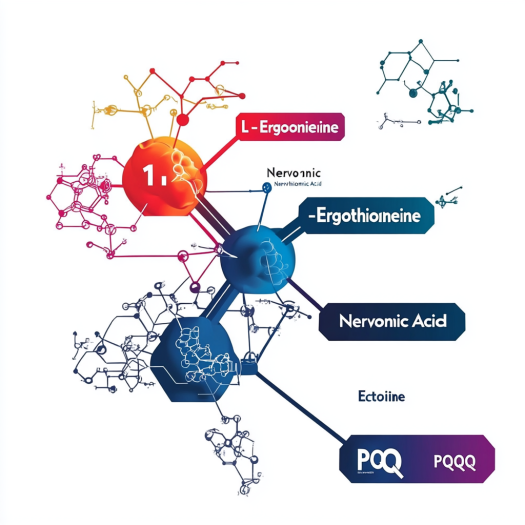
I still remember the jolt of excitement the day ergothioneine finally earned its coveted GRAS badge—then the reality of compliance paperwork hit me like a freight train.
Ergothioneine’s 2025 GRAS status means U.S. brands can legally add this amino-acid antioxidant to foods and supplements, yet staying compliant demands careful supplier vetting, rock-solid documentation, transparent labeling, and ongoing stability testing—fail just one link and the FDA can halt your launch.
Breathe. I’ve walked this path with clients from concept to shelf; here’s the roadmap I wish I’d had on day one.
What Does GRAS Really Mean for Ergothioneine in 2025?
Twenty-five words: “Generally Recognized As Safe” sounds comforting, but it’s not a one-time trophy; it’s a living promise that your ingredient and usage stay scientifically sound.
GRAS for ergothioneine hinges on publicly available safety data, expert consensus, and sticking to the FDA-affirmed purity, dosage, and intended-use limits; drift outside the published range and you lose protection.

The backstory: When the FDA accepted the independent panel’s conclusion that ergothioneine (up to 30 mg per day in conventional foods and 5 mg per serving in beverages) was safe, doors swung open for formulators. But GRAS isn’t a golden ticket you tuck in a drawer—it’s a living standard tethered to how you manufacture, how much you use, and where you place it on the label.
Regulatory heartbeat
- Static criteria: The molecular identity (L-ergothioneine from fermentation), absence of harmful solvents, and purity ≥ 98 %.
- Dynamic criteria: Emerging research, adverse-event reports, and cumulative exposure across food categories1.
Think of GRAS like owning a driver’s license—you passed the test, but you still need to obey speed limits. If you decide to triple serving sizes or pivot from beverage to toddler snacks, you may cruise right past the exposure ceiling and into FDA scrutiny.
A quick anecdote: One beverage client decided to “boost consumer appeal” by doubling ergothioneine per can without running the numbers. A routine retailer audit flagged the discrepancy; they spent six months reformulating and re-printing labels. A costly lesson in staying inside the lane.
Your ongoing obligations
- Supplier audits every 12 months.
- Batch-specific certificates showing identity, purity, microbial limits.
- Post-market surveillance to capture any consumer complaints, however minor.
The payoff for all that diligence? Peace of mind—and a launch timeline measured in weeks, not quarters.
How Do I Confirm My Ergothioneine Source Meets GRAS Specifications?
My first rule of thumb: don’t just ask for a COA—ask to see the fermenter. Virtual tours count, but real audits earn trust.
To satisfy GRAS, your supplier must prove strain pedigree, solvent-free processing, ≥ 98 % purity, heavy-metal compliance, and batch-to-batch consistency; third-party testing and GMP certificates make your due-diligence file bulletproof.
When I visit our own fermentation facilities, I still geek out over the stainless-steel bioreactors humming in orderly rows. But glossy photos alone won’t keep an FDA inspector happy. Here’s exactly what I collect before signing any purchase agreement:
| Checklist Item | Why It Matters | Red Flag if Missing |
|---|---|---|
| Strain lineage documentation | Ensures non-toxic, non-GMO classification under current GRAS notice | “Proprietary, can’t share” replies |
| Full process flowchart | Confirms solvent-free extraction and in-process controls | Vague descriptions like “proprietary purification” |
| ISO & GMP certificates | Shows site follows food-grade quality systems | Certificates expired or issued by unknown body |
| Third-party COA | Verifies identity, purity, microbes, heavy metals | In-house lab only, no external validation |
Field story
Two years ago, a Midwest supplement brand sourced “discount ergothioneine2” that looked legit on paper—until tablets turned beige within weeks. The culprit? Residual protein impurities from shortcuts in downstream filtration. The brand re-launched with our verified material, but not before a wave of social-media complaints. Lesson learned: the cheapest kilo rarely carries the best audit trail.
Practical tip: Request at least three consecutive batch COAs. Consistency is king; wild swings in arginine content or microbial load hint at process drift.
Which Documents Does the FDA Expect During Ingredient Review?
Paperwork sounds boring—until you’re staring at a Form 483 citation. Let’s get ahead of that.
The FDA can ask for master batch records, stability data, toxicology references, allergen statements, and your self-affirmed GRAS dossier; organize these in a single digital binder and update quarterly.

I keep a laminated flowchart on my office wall—yes, old-school—mapping every document from “fermenter” to “finished product.” Here’s a streamlined version:
| Section | Key Files | Update Frequency |
|---|---|---|
| Identity | Strain lineage, genetic stability report | When strain changes |
| Purity & Specs | COAs, heavy-metal reports, residual-solvent certificates | Each batch |
| Safety | Published toxicology, human-clinical abstracts, adverse-event logs | Annually |
| Exposure & Intended Use | Calculation worksheets showing daily intake across categories | Anytime you reformulate |
| Manufacturing | SOPs, master batch records, cleaning validation | Reviewed annually |
| Stability | Real-time and accelerated studies | Ongoing, at least 3 lots |
Real-life rescue: A client’s warehouse fire triggered temperature excursions, and the FDA requested proof that 45 °C didn’t break ergothioneine’s stability. Thankfully, we had accelerated data in the binder, and the inspector smiled (yes, really) and closed the file within minutes.
Prepare for unannounced audits
- Store docs in the cloud with version control.
- Assign a single “document shepherd” on your team.
- Rehearse rapid retrieval: can you locate the last heavy-metal report in under 90 seconds?
If you nail the paperwork drill, inspections feel less like root canals and more like coffee chats.
Where Do Labeling Errors Trip Up Most Supplement Brands?
Short answer: serving size, common name, and that sneaky asterisk next to the daily value.
Labels must list “L-Ergothioneine (from fermentation)” in supplement facts, reflect precise per-serving milligrams within GRAS limits, state “antioxidant amino acid,” and avoid disease claims; tiny slip-ups invite warning letters.
The anatomy of a compliant label: I like to dissect mock-ups with a red marker. The three hot zones:
-
Supplement Facts panel
- Ingredient name: “L-Ergothioneine (fermentation).”
- Quantity: use mg, not “% blend.”
- Serving size: align with GRAS intake (≤ 30 mg/day total).
-
Structure/function claims
- Safe: “supports cellular antioxidant defense.”
- Risky: “treats neurodegenerative disease” (invites drug classification).
-
Other label real estate
- Allergen statement (“contains no soy, dairy, or gluten”).
- Contact phone/web for adverse events (21 CFR 111).
Case study: One West-Coast startup borrowed brain-health claims from a resveratrol product and pasted them onto ergothioneine gummies. Within seven weeks, the FDA’s warning letter—notorious public PDF—popped up in Google search results. Sales tanked. They salvaged reputation only after a hasty reprint and social-media transparency campaign.
Pro tip: Run every claim through the FDA’s CPG 400.100 on “Structure/Function Claims” and snap a screenshot for file. If a copywriter tweaks wording later, you’ll know exactly what got approved.
When Should You Start Stability and Allergen Testing?
Answer: before your first pilot batch ships—otherwise you’re driving blind.
Begin accelerated stability (40 °C/75 % RH, 6 months) and real-time studies as soon as final packaging is chosen; include common allergen panels even if ergothioneine is naturally allergen-free to pre-empt customer fears.

I once had a mentor who said, “Products don’t fail in the lab; they fail in the warehouse.” He was right. Heat, light, oxygen—each one nibbles away at potency. Here’s my go-to timeline:
| Month | Action | Why It Matters |
|---|---|---|
| 0 | Bench formulation freeze | Locks recipe for testing |
| 1 | Accelerated study launch | Worst-case stress screening |
| 3 | First potency check | Triggers formulation tweak if loss > 5 % |
| 6 | Packaging validation (drop, UV) | Ensures travel-ready durability |
| 12 | Real-time data checkpoint | Supports 2-year shelf-life claim |
Sensory surprises: Ergothioneine itself is odorless, but added to vanilla protein powder it can react with aldehydes, causing a faint sulfur note after three months. A tiny tweak—encapsulating with acacia gum—solved the problem, but only because stability testing caught it early.
Allergen clarity
- Even if raw material is allergen-free, cross-contact during capsule filling can introduce soy or dairy traces.
- Use third-party labs with ELISA kits sensitive to 5 ppm.
- Publish a QR code on the label linking to allergen certificate; consumers love transparency.
Invest upfront, and you’ll avoid mid-shelf recall nightmares that drain both bank account and brand trust.
Why Does Partnering with a Fermentation Specialist Simplify Compliance?
I’ll be blunt: trying to navigate GRAS alone is like hiking the Rockies in flip-flops—you might finish, but expect bruises.
A specialist like Santa Biotech delivers solvent-free fermentation, batch-level documentation, tech support for labeling, and stability data, shaving months off launch timelines and slashing regulatory risks.
When brand owners tour our facility, the conversation inevitably shifts from “price per kilo” to the steady hum of automation. Stainless tanks monitor pH and dissolved oxygen every few seconds; AI dashboards flag anomalies before they breach spec. This precision isn’t just for bragging rights—it’s compliance insurance.
Five pain points we solve
- Document overload – We hand you a digital binder with every certificate pre-indexed.
- Purity anxieties – ≥ 99 % assay confirmed by Eurofins.
- Label headaches – Our regulatory team reviews artwork before you hit “print.”
- Formulation puzzles – Need ergothioneine to stay stable in sparkling water? We’ve nailed the anti-foaming agent game.
- Supply disruptions – Five parallel production lines keep OTIF metrics above 96 %.
Coffee chat anecdote: A Tennessee startup CEO told me he burned four months convincing a contract manufacturer that ergothioneine was legal. One call with our regulatory specialist, one forwarded GRAS notice, and production started in ten days. He joked that hiring us felt like downloading expertise directly into his brain.
Curious how collaboration could look? Peek at our pharmaceutical-grade ergothioneine and drop me a line—no hard sell, just straight answers.
Conclusion
Compliance isn’t paperwork; it’s consumer trust—nail the details and ergothioneine becomes the hero of your 2025 product line.

